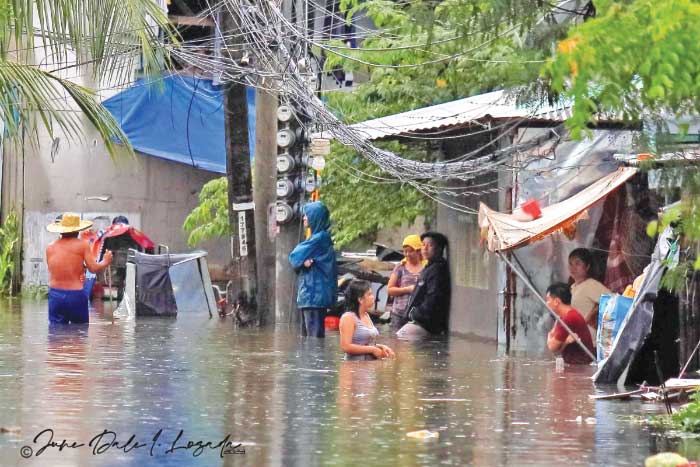
By Joseph Bernard A. Marzan
The Iloilo City Disaster Risk Reduction and Management Office (CDRRMO) has identified 72 barangays that may be most affected by the incoming La Niña phenomenon, though all barangays are advised to prepare.
Darwin Papa, head of the CDRRMO’s operations center, told Daily Guardian that these barangays are located near major waterways, such as the Jaro River, Jaro Floodway, Dungon Creek, and Calajunan Creek.
Papa said around 240,000 residents could be affected by flooding, based on their Climate and Disaster Risk Assessment (CDRA) conducted in 2020.
“These barangays are being monitored and engaged to prepare and activate their Barangay DRRM committees,” Papa said in a phone interview.
“We have almost the whole Jaro area beside the major river systems. Specifically, those at most risk, based on our study, are 72 barangays, considered very high risk to flooding with an affected population of roughly 240,000,” he added.
Barangays with the greatest flood risk include:
Arevalo: Sto. Niño Sur, Calaparan, Sto. Niño Norte, Sooc, and Yulo Drive
City Proper: Tanza Baybay, Ortiz, and Tanza Esperanza
Jaro: Lanit, Camalig, Dungon B, Tabuc Suba, Balabago, Calubihan, Cubay, San Isidro, and Tagbak
La Paz: Baldoza, Ingore, and Ticud
Lapuz: Barrio Obrero, Don Esteban, and Mansaya
Mandurriao: Bakhaw, Navais, Airport, Bolilao, and Pali Benedicto
Molo: Calumpang, Boulevard, San Juan, West Habog-habog, and West Timawa
Papa also noted that the risk is not limited to these 72 barangays, as areas typically spared from flooding can be affected by intensified rainfall.
“Some of these barangays, although they don’t belong to those [considered as] high-risk, there are instances when, during rain time, especially raining now is not generalized, in these instances, there are more barangays affected by the water because of the volume of rainfall,”
The CDRRM Council’s response cluster met last week to discuss preparations for the rainy season following the entry of Typhoon Aghon.
Agreements included heightened weather monitoring, equipment maintenance, and widespread dissemination of preparedness measures with assistance from media and stakeholders.
“[The response cluster has] been placed on high alert and preparedness status, to monitor weather updates being sent by the operations center so that they would be ready in case the cluster needs to be activated for any eventualities, and at the same time, to report to the operations center any activities they have in their [other] assigned clusters,” he said.
Regarding drainage issues, especially in City Proper, two pumping stations located near Jalandoni Street and Delgado Extension are ready to pump water from major drainage holding tanks.
“We have gradually minimized [drainage issues], however, that is our concern, that during periods of heavy rainfall and coinciding with high tide, their function becomes limited because of the low elevation, so it would be difficult to siphon out even with the drainage stations,” Papa said.
The CDRRMO has been urging the public, especially in low-elevation areas, to clean canals and drainages to prevent clogging and worsened flooding.
“We have been campaigning for the public to clean their canals and drainage systems. Blockages from improperly disposed waste have been major causes of flooding,” he said.
Papa added that the Philippine Atmospheric, Geophysical and Astronomical Services Administration’s (PAGASA) forecasts indicate scenarios where the heat index may reach 43 to 44 degrees Celsius, despite the transition to the southwest monsoon season.
PAGASA has yet to declare the official start of La Niña, but considers June, July, and August as “transition months” from El Niño.
“There will be periods of heavy rains and extreme heat as the rainy season has not fully developed,” he remarked.
EL NIÑO
Papa also discussed the effects of the El Niño phenomenon, which PAGASA declared ended on June 7.
He said that while the city’s agricultural areas were not affected as much, the effects were most felt by the ‘green areas’ maintained by the city government.
These include the plants in the 7 district plazas, and along the stretch of the Iloilo River Esplanade and the Benigno Aquino Avenue (Diversion Road).
“During the El Niño months, crops planted by [those in the agricultural areas] were resistant to high temperatures, as well as summer crops, so the effects in terms of agriculture were minimal,” he said.
“Almost 80 percent was damaged, and many plants actually died, especially in the green areas maintained by the city government. These were damaged and right now, it had become difficult to the point where the water supply started to dwindle and the city had to look for alternative water supply,” he added.
The city government has distributed 5.2 million liters of water to 64 barangays under a State of Calamity and continues to distribute water to affected barangays.
Daily Guardian has reached out to Provincial Disaster Risk Reduction and Management Office head Cornelio Salinas for the Iloilo provincial government’s preparations for La Niña, but he has not responded as of this writing.





















